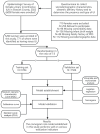Development and Validation of a Risk Prediction Model for Female Stress Urinary Incontinence in Rural Fujian, China
- PMID: 38707519
- PMCID: PMC11069356
- DOI: 10.2147/RMHP.S457332
Development and Validation of a Risk Prediction Model for Female Stress Urinary Incontinence in Rural Fujian, China
Abstract
Purpose: With China's rapidly aging population and the rising proportion of obese people, an increase in the number of women suffering from urinary incontinence (UI) is to be expected. In order to identify high-risk groups before leakage occurs, we aimed to develop and validate a model to predict the risk of stress UI (SUI) in rural women.
Patients and methods: This study included women aged 20-70 years in rural Fujian who participated in an epidemiologic survey of female UI conducted between June and October 2022. Subsequently the data was randomly divided into training and validation sets in a ratio of 7:3. Univariate and multivariate logistic regression analyses were used to identify independent risk factors as well as to further construct a nomogram for risk prediction. Finally, concordance index (C-index), calibration curve and decision curve analysis were applied to evaluate the performance of the predictive models.
Results: A total of 5290 rural females were enrolled, of whom 771 (14.6%) had SUI. Age, body mass index (BMI), postmenopausal status, number of vaginal deliveries, vaginal delivery of large infant, constipation and family history of pelvic organ prolapse (POP) and SUI were included in the nomogram. C-index of this prediction model for the training and validation sets was 0.835 (95% confidence interval [CI] = 0.818-0.851) and 0.829 (95% CI = 0.796-0.858), respectively, and the calibration curves and decision analysis curves for both the training and validation sets showed that the model was well-calibrated and had a positive net benefit.
Conclusion: This model accurately estimated the SUI risk of rural women in Fujian, which may serve as an effective primary screening tool for the early identification of SUI risk and provide a basis for further implementation of individualized early intervention. Moreover, the model is concise and intuitive, which makes it more operational for rural women with scarce medical resources.
Keywords: nomogram; predict model; risk factors; rural women; stress urinary incontinence.
© 2024 Wang et al.
Conflict of interest statement
The authors report no conflicts of interest in this work.
Figures





Similar articles
-
Establishment and validation of a simple nomogram for predicting early postpartum stress urinary incontinence among women with vaginal delivery: a retrospective study.BMC Womens Health. 2023 Jan 9;23(1):8. doi: 10.1186/s12905-023-02160-2. BMC Womens Health. 2023. PMID: 36624424 Free PMC article.
-
Development and external validation of clinical predictive model for stress urinary incontinence in Chinese women : a multicenter retrospective study.BMC Womens Health. 2024 Sep 27;24(1):532. doi: 10.1186/s12905-024-03363-x. BMC Womens Health. 2024. PMID: 39334141 Free PMC article.
-
External validation of a model predicting de novo stress urinary incontinence after pelvic organ prolapse surgery.Neurourol Urodyn. 2021 Feb;40(2):688-694. doi: 10.1002/nau.24608. Epub 2021 Jan 25. Neurourol Urodyn. 2021. PMID: 33492730
-
A nomogram model predicting the risk of postpartum stress urinary incontinence in primiparas: A multicenter study.Taiwan J Obstet Gynecol. 2022 Jul;61(4):580-584. doi: 10.1016/j.tjog.2022.04.004. Taiwan J Obstet Gynecol. 2022. PMID: 35779903 Review.
-
Vaginal Pessaries for Pelvic Organ Prolapse or Stress Urinary Incontinence: A Health Technology Assessment.Ont Health Technol Assess Ser. 2021 May 6;21(3):1-155. eCollection 2021. Ont Health Technol Assess Ser. 2021. PMID: 34055111 Free PMC article.
Cited by
-
Predictive Model of Internal Bleeding in Elderly Aspirin Users Using XGBoost Machine Learning.Risk Manag Healthc Policy. 2024 Sep 18;17:2255-2269. doi: 10.2147/RMHP.S478826. eCollection 2024. Risk Manag Healthc Policy. 2024. PMID: 39309118 Free PMC article.
-
Risk factors and a predictive model for mixed urinary incontinence among parous women: Insights from a large-scale multicenter epidemiological investigation.Digit Health. 2025 Apr 3;11:20552076251333661. doi: 10.1177/20552076251333661. eCollection 2025 Jan-Dec. Digit Health. 2025. PMID: 40190338 Free PMC article.
-
Machine learning in female urinary incontinence: A scoping review.Digit Health. 2024 Oct 7;10:20552076241281450. doi: 10.1177/20552076241281450. eCollection 2024 Jan-Dec. Digit Health. 2024. PMID: 39381822 Free PMC article.
References
LinkOut - more resources
Full Text Sources

